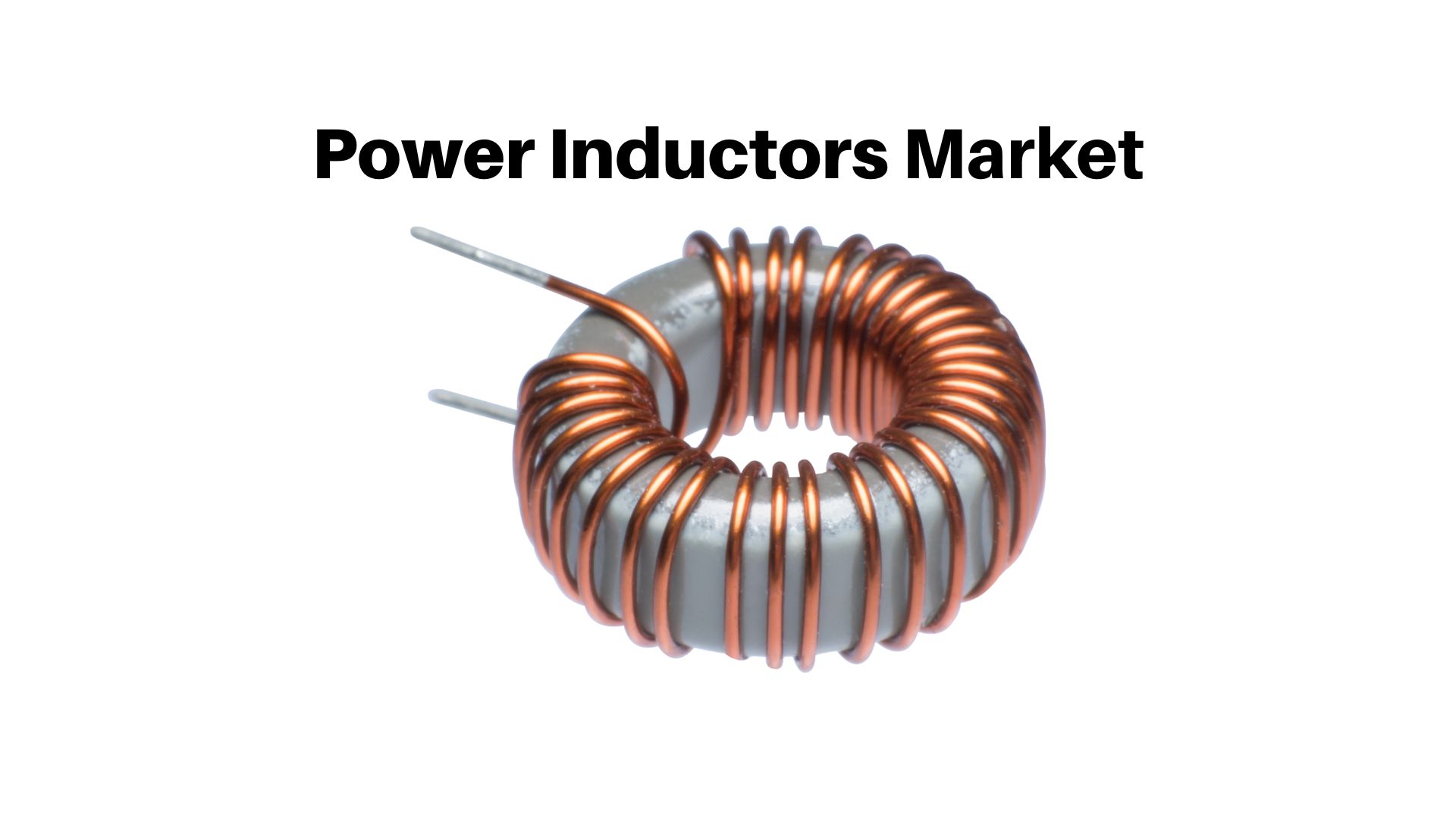Power Inductors Market Expected To Reach USD 2.95 Bn By 2032

Page Contents
Market Overview
Published Via 11Press: The global power inductor market was valued USD 1.68 billion in 2022 and it is forecast to experience a compound annual growth rate (CAGR) of 5.8% from 2022-2032.
Power inductors are essential components of electronic devices that store energy in magnetic fields. They find widespread application in automotive, consumer electronics, industrial automation, and telecommunications networks alike.
Power inductors are in high demand due to the growing adoption of electric vehicles, the need for renewable energy sources, and the rising number of consumer electronics devices. Furthermore, the rapid expansion of the internet of things (IoT) and 5G network is expected to further accelerate market growth.
Request For Sample Report Here: https://market.us/report/power-inductors-market/request-sample
Key Takeaway
- The power inductor market is expected to experience steady growth throughout the forecast period due to increasing demand for electronic devices, the rise of electric vehicles, and the expansion of IoT and 5G networks.
- Asia-Pacific is the leading market for power inductors and is expected to remain in this position throughout the forecast period. Furthermore, applications such as automotive, consumer electronics, industrial automation, and telecommunications are driving growth within this region.
- Overall, the power inductor market offers an exciting prospect for businesses and investors in the electronics sector.

Regional Snapshot
- Asia-Pacific: The Asia-Pacific region dominates the power inductor market, accounting for the majority of sales. This growth can be attributed to rising consumer electronics demand, expansion in automotive industries, and rapid IoT/ 5G network development. Countries such as China, Japan, South Korea, and India are major drivers behind this expansion within this region.
- North America: The North American power inductor market is being driven by rising demand for electric vehicles, the increasing use of renewable energy sources, and advances in technologies such as artificial intelligence (AI) and machine learning (ML). The United States and Canada are the major contributors to market growth within this region.
- Europe: The European power inductor market is being driven by the rising adoption of electric vehicles, the growing use of renewable energy sources, and the development of smart cities. Germany, the United Kingdom, France, and Italy are the major contributors to market growth within this region.
- Middle East and Africa: The power inductor market in the Middle East and Africa is being driven by rising demand for energy-saving systems, the expansion of telecom industries, and the development of smart cities. Countries such as United Arab Emirates, Saudi Arabia, and South Africa are major contributors to market growth within this region.
Drivers
- Increasing Demand for Electronic Devices: As more electronic devices such as smartphones, laptops, and tablets become popular, the demand for power inductors – essential components of these gadgets – is rising.
- Adoption of Electric Vehicles: The growing popularity of electric vehicles is driving demand for power inductors, which are used in power electronics systems to regulate electrical energy flow.
- Expansion of Renewable Energy Sources: The expanding use of renewable energies such as solar and wind power is driving up demand for power inductors, which are employed in power electronics to regulate and convert electrical energy.
- Growth of the Internet of Things (IoT): The exponential expansion of the IoT is driving demand for power inductors, which are used in sensors, controllers, and other electronic devices that are interconnected with it.
- Development of 5G Network: The growth of the 5G network is driving demand for power inductors, which are essential components in power electronics used in 5G infrastructure to regulate and convert electrical energy.
- Increasing Demand for Energy-Efficient Systems: The rising need for energy-efficient systems is propelling the demand for power inductors, which are used in power electronics to reduce power consumption and boost efficiency.
Restraints
- High Cost of Raw Materials: Raw materials such as copper and aluminum, which are used to manufacture power inductors, can be highly volatile in price. This could affect both production costs and pricing for power inductors.
- Competition from Alternative Technologies: Alternative technologies such as capacitors and transformers could replace power inductors in certain applications, potentially restricting the growth of the power inductor market.
- Limited Access to Raw Materials: The scarcity of certain raw materials, especially rare-earth metals used in certain power inductors, could potentially limit the market growth.
- Challenges of Miniaturization: The trend towards miniaturizing electronic devices presents a challenge to the power inductor market, as designing and manufacturing small-sized power inductors that meet the required specifications can be challenging.
- Regulatory Challenges: The power inductor market is subject to various regulations and standards that could drive up compliance costs and hinder market expansion.
Opportunities
- Intense competition: The power inductor market is highly competitive, with a large number of manufacturers operating in the market. This can lead to pricing pressures and reduced profit margins.
- Rapid technological advancements: The rapid pace of technological advancements in the electronics industry presents a challenge for power inductor manufacturers, who must continually innovate and improve their products to stay competitive.
- The complexity of design and production: Power inductors are complex components that require specialized design and production processes. This can lead to longer lead times and higher production costs.
- Volatile raw material prices: The cost of raw materials such as copper and aluminum, which are used to manufacture power inductors, can be volatile, which can impact the production cost and pricing of power inductors.
- Supply chain disruptions: The power inductor market is subject to supply chain disruptions, such as disruptions in the availability of raw materials, which can impact the production and delivery of power inductors.
- Regulatory compliance: The power inductor market is subject to various regulations and standards, which can increase compliance costs and impact market growth.
View Detailed TOC of the Report | https://market.us/report/power-inductors-market/table-of-content/
Challenges
- Power inductor market: The power inductor market is highly competitive, with a large number of manufacturers operating within it. This can result in pricing pressures and reduced profit margins for vendors.
- Rapid Technological Advances: The rapid pace of technological innovation in the electronics industry presents power inductor manufacturers with a challenge; they must continuously innovate and enhance their products to stay ahead of competitors.
- The complexity of Design and Production: Power inductors are intricate components that necessitate specialized design and manufacturing processes, leading to longer lead times and higher production costs.
- Volatile Raw Material Prices: Raw materials like copper and aluminum, which are used to manufacture power inductors, may have fluctuating prices. This could impact the production costs and pricing of power inductors.
- Supply chain Disruptions: The power inductor market can experience supply chain interruptions, such as shortages in raw materials that could disrupt the production and delivery of power inductors.
- Regulatory Compliant Market: The power inductor market is subject to various regulations and standards that could drive up costs of compliance and hinder market expansion.
Key Market Segments
Type
- SMD Power Inductors
- Plug-in Power Inductors
Application
- Mobile Phone
- Consumer Electronics
- Computer & Office
- Automotive
- Industry
- Telecom/datacomm
- Others
Key Market Players
- TDK
- Murata
- Vishay
- Taiyo Yuden
- Sagami Elec
- Sumida
- Chilisin
- Mitsumi Electric
- Shenzhen Microgate Technology
- Delta Electronics
- Sunlord Electronics
- Panasonic
- AVX (Kyocera)
- API Delevan
- Wurth Elektronik
- Littelfuse
- Pulse Electronics
- Coilcraft, Inc
- Ice Components
- Bel Fuse
Report Scope
| Report Attribute | Details |
| The market size value in 2022 | USD 1.68 Bn |
| Revenue forecast by 2032 | USD 2.95 Bn |
| Growth Rate | CAGR Of 5.8% |
| Regions Covered | North America, Europe, Asia Pacific, Latin America, and Middle East & Africa, and Rest of the World |
| Historical Years | 2017-2022 |
| Base Year | 2022 |
| Estimated Year | 2023 |
| Short-Term Projection Year | 2028 |
| Long-Term Projected Year | 2032 |
Frequently Asked Question
Q: What is the current market size for the Power Inductors Market?
A: According to a report by Market.us, the Power Inductors Market was valued at USD 1.68 billion in 2022 and is expected to reach USD 2.95 billion by 2032, growing at a CAGR of 5.8% during the forecast period.
Q: What are the key segments of the Power Inductors Market?
A: The Power Inductors Market can be segmented based on Type (SMD Power Inductors, Plug-in Power Inductors), By Application (Mobile Phone, Consumer Electronics, Computer & Office, Automotive, Industry, Telecom/datacomm, Others), and geography (North America, Europe, Asia-Pacific, Latin America, and Middle East & Africa).
Q: Who are the key players in the Power Inductors Market?
A: Some of the key players in the Power Inductors Market include TDK, Murata, Vishay, Taiyo Yuden, Sagami Elec, Sumida, Chilisin, Mitsumi Electric, Shenzhen Microgate Technology, Delta Electronics, Sunlord Electronics, Panasonic, AVX (Kyocera), API Delevan, Wurth Elektronik, Littelfuse, Pulse Electronics, Coilcraft, Inc, Ice Components, Bel Fuse.
The team behind market.us, marketresearch.biz, market.biz and more. Our purpose is to keep our customers ahead of the game with regard to the markets. They may fluctuate up or down, but we will help you to stay ahead of the curve in these market fluctuations. Our consistent growth and ability to deliver in-depth analyses and market insight has engaged genuine market players. They have faith in us to offer the data and information they require to make balanced and decisive marketing decisions.



